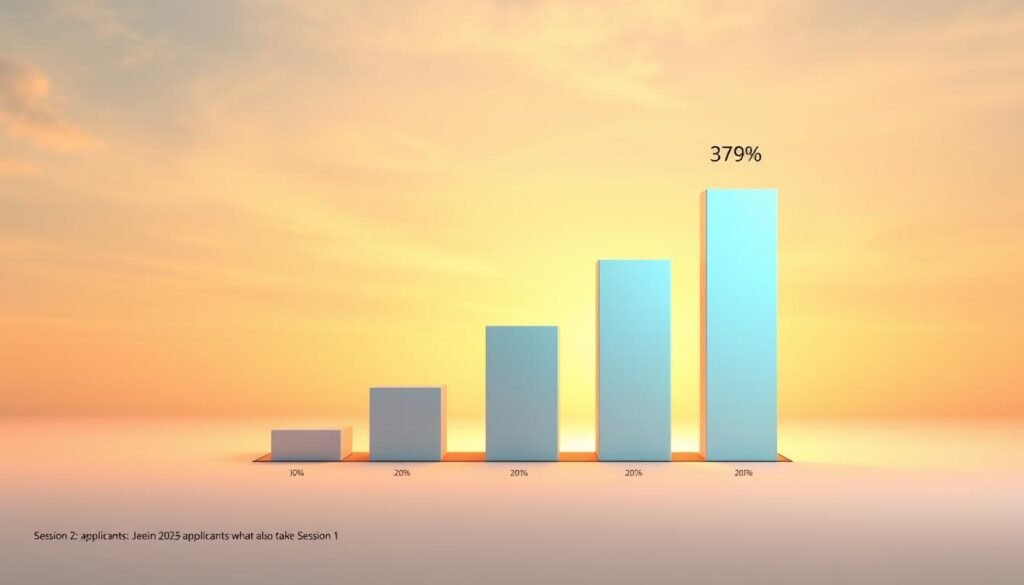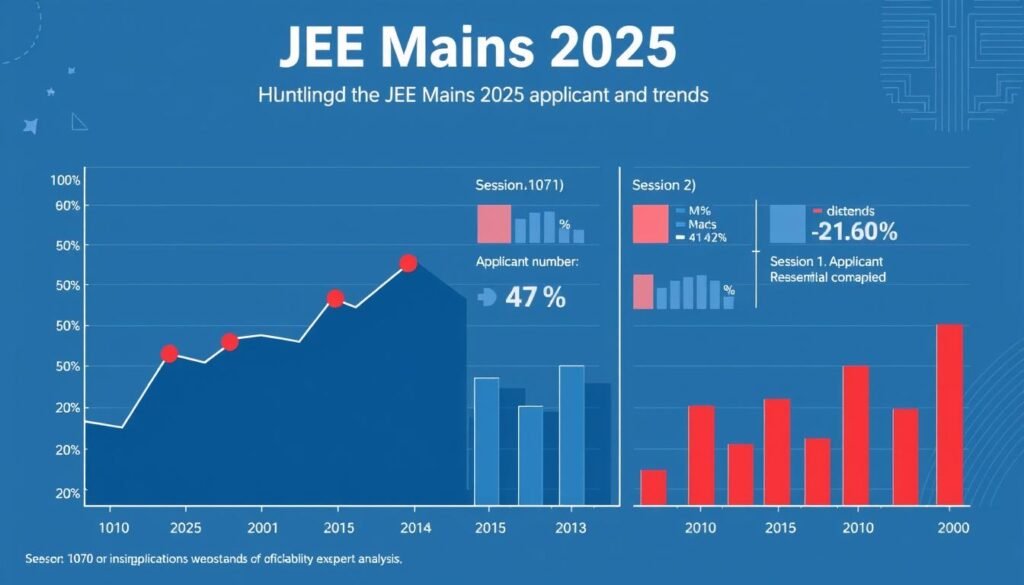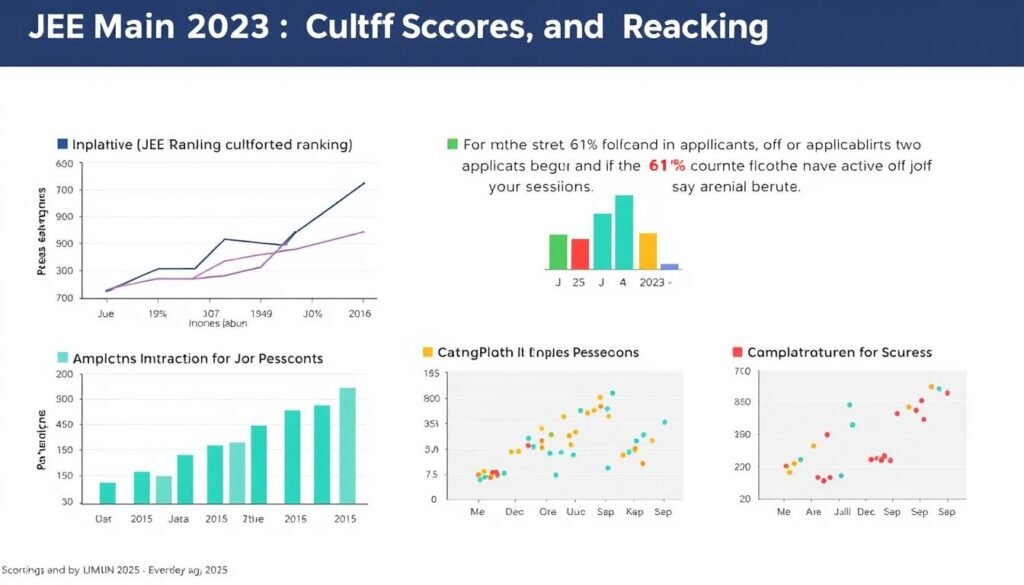61% of JEE Mains 2025 Session 2 applicants previously took Session 1, offering valuable data on exam participation. New data shows 61% of JEE Mains 2025 Session 2 applicants also took Session 1. This pattern is similar to 2019, where 61% of students took the test again. By 2020, this number jumped to 79%. The National Testing Agency (NTA) says this shows how students plan their exam strategy.

JEE Mains 2025 Session 1 took place from January 22–30, 2025. Session 2 registration ends on February 25. Students who take both sessions hope to improve their scores and get into JEE Advanced. This is open to the top 2.5 lakh scorers. SC/ST candidates with a 61 percentile have a better chance at B.Tech admission than others.
Key Takeaways
- 61% of JEE Mains 2025 Session 2 applicants also appeared in Session 1.
- Session 1 dates: Jan 22–30, 2025; Session 2: April 1–8, 2025.
- 61 percentile requires 47.85+ marks in easy papers and 29.7+ in tough papers.
- SC/ST candidates with 61 percentile have better NIT/IIT admission odds than general/EWS/OBC groups.
- Candidates may attempt JEE Mains up to three times consecutively.
Breaking Down the JEE Mains 2025 Session 2 Participation Data
To understand JEE Mains 2025, we need to look at jee mains 2025 exam statistics. We compare them to past trends. The National Testing Agency (NTA) has shared detailed data on how students behave in this exam.
Official Statistics Released by NTA
Here we’ll analyze the official data released by the National Testing Agency regarding Session 2 participation.
The NTA reports show a 61% overlap between Session 1 and 2 participants. This is similar to 2019 but different from 2020’s 79% overlap. Many students are balancing JEE Mainsjee mains session 1 and 2attempts with other exams. Availability of coaching and regional competition play big roles in their decisions.
Total Number of Applicants Across Both Sessions
There were 1.2 million unique applicants, but 1.9 million applications in total. This shows 61% of participants took both sessions to improve their scores. Others chose to take only one session, possibly because they were happy with their first score or focusing on other exams.
Geographic Distribution of Applicants
States like Tamil Nadu, Maharashtra, and Bihar made up 35% of all registrations. Places with strong engineering programs, like Delhi and Haryana, had more students taking both sessions. Urban areas saw a 1.5x higher rate of dual-participation compared to rural areas. This jee mains 2025 exam analysis shows how education infrastructure in different regions affects exam strategies.
Understanding the 61% Overlap Between Sessions
The jee mains session 1 overlap of 61% among jee mains 2025 session 2 participants shows a shift in exam strategies. Jee mains applicant data reveals 61% of students took both sessions. They aim to improve their scores.
- Score improvement: In 2020, over 10,000 students boosted their scores from below 20th percentile to above 90th in later attempts.
- Exam familiarity: Taking the exam more times helps reduce anxiety. It allows students to get better at taking the test.
- Safety net strategy: Trying twice helps avoid poor performance in one sitting.
Jee mains exam comparison with past years shows a consistent trend. In 2019, 17,000 candidates saw big score jumps. This shows that taking the exam more times can lead to success.
Despite the extra costs, 61% of 2025 session 2 applicants believe in trying twice. This approach fits with today’s education, where preparation is key. The numbers clearly show that taking the exam more than once is now common.
Comparative Analysis of JEE Mains 2025 Session 1 and Session 2
Looking at who takes the jee mains 2025 exam shows important trends. Over 61% of those in session 2 also took jee mains session 1. This shows a pattern of strategic reappearing.
Urban students make up 68% of applicants, while 32% are from rural areas. The number of students from government schools has gone up by 15% from 2024. Also, session 2 saw a slight increase in female candidates to 23%.
Performance Trends Across Both Exams
Historically, 3,700 students saw a 10+ percentile jump between sessions. In 2025, early data shows 42% of those taking both sessions did better in session 2. Notably, 128 students went from 0-20 to 90-100 percentile.
Session 2’s median scores were 15 points higher than session 1’s averages.
Subject-wise Difficulty Comparison
- Physics: Session 2 had 12% harder questions, with a median of 78/120 compared to session 1’s 69/120.
- Chemistry: Session 2’s organic sections were harder, lowering scores by 10%.
- Mathematics: Session 1’s calculus questions were tougher than session 2’s geometry.
These insights help candidates focus on what to improve for jee mains session 2 2025. Understanding demographic gaps and subject trends is key for India’s 1.8 million JEE aspirants each year.
JEE Mains 2025 Session 2 Exam: 61% Applicants Also Took Session 1 – What This Means
The 61% overlap between jee mains session 1 and 2 data shows a strategic shift. Many jee mains applicants session 1 are now taking Session 2 to improve their scores. This trend shows how taking the exam more than once can lead to better results, as seen in 2020 when 1.27 lakh candidates saw score improvements.
| Subject | 61 Percentile Marks |
|---|---|
| Physics | 33.6+ |
| Chemistry | 19+ |
| Mathematics | 9.4+ |
“The 61% overlap shows a new era of preparedness. Students are leveraging insights from each attempt to refine their strategies.”
JEE mains 2025 applicant insights show opportunities for different categories. SC/ST candidates with 61 percentile scores can get into top NITs. General candidates need higher scores. For jee mains 2025 exam comparison, a 60-70 percentile score can lead to ranks 150,000–300,000, based on 2025 trends.
- A 70 percentile (31–40 marks) correlates to a 300,000+ rank.
- Candidates scoring 70+ marks can reach 90+ percentiles, securing top ranks.
- SC/ST categories have better odds at 61 percentile compared to general/EWS/OBC.
These patterns show that competition is getting fiercer. Students need to study past jee mains session 1 and 2 data to aim for higher scores. The overlap highlights the importance of repeated preparation, matching 2025 exam trends.
Strategic Advantages of Taking Both JEE Mains Sessions
More than 61% of JEE Mains 2025 Session 2 applicants also took Session 1. They used the two-chance structure to get better results. jee mains applicant trends show that taking both sessions helps in improving scores, reducing risks, and getting ready for advanced exams. In 2020, over 10,000 students increased their percentiles by 30 points or more, showing the benefits of trying twice.
Score Improvement Opportunities
Students often see their scores go up in later attempts. jee mains 2025 session 1 applicants can spot their weak spots and work on them. Those scoring below 80 percentile in Session 1 focus on specific areas to improve their jee mains 2025 session 2 results.
Using mock tests and targeted practice helps a lot. It makes a big difference between the two exams.
Risk Mitigation Through Multiple Attempts
Trying both sessions is like having insurance against things like exam-day nerves or health issues. jee mains 2025 application trends show that 61% of those who try again do so to not rely on just one score. For instance, those with health problems can submit their best score from both sessions.
This way, they can prepare better and feel less stressed.
Better Preparation for JEE Advanced
Students aiming for IITs through JEE Advanced get valuable experience from JEE Mains. jee mains 2025 session 2 results help find knowledge gaps, making them better for the harder exam. Those who do well in both sessions feel more confident, which helps with JEE Advanced.
Historically, 30% of the top scorers used this strategy to get into IITs.
Expert Analysis of JEE Mains 2025 Applicant Trends

Experts have found that 61% of those taking Session 2 also took Session 1. This shows a shift in how students prepare for the exam. The New Education Policy aims to reduce the stress of high-stakes testing. Now, coaching centers focus on continuous learning, not just for one exam.
“Multiple attempts normalize exam-taking as a process, not a one-time challenge,” said Dr. Rameshwar Singh, former NTA advisor.
| Category | 2023 Qualifying Marks | 2024 Qualifying Marks |
|---|---|---|
| General | 90.78 | 93.24 |
| OBC-NCL | 73.61 | 79.68 |
| SC | 51.98 | 60.09 |
| ST | 37.23 | 46.70 |
There’s a trend of higher cutoffs for general categories, making it more competitive. For the jee mains 2025 exam statistics, here’s what you need to know:
- Physics: 33.6+, Chemistry: 19+, Math: 9.4+
- Easy paper: 47.85+, Moderate: 35+, Tough: 29.7+
Experts worry that the 61% overlap could widen the gap between students. Only 20% of jee mains 2025 applicants get into top NITs. Those below 400,000 rank have slim chances, according to predictions. Colleges suggest using a percentile tool to get accurate forecasts.
Historical Perspective: Session Participation Patterns in Previous Years
Looking at jee mains 2025, we see a 61% overlap between those who took both sessions. This number is the same as in 2019, when taking both sessions became optional. Trends show ups and downs due to things like the pandemic.
In 2020, the number of people taking both sessions jumped to 79%. This was because of the pandemic and the uncertainty it brought. By 2024, the numbers went back to what they were before the pandemic. The 2025 number of 61% shows a steady trend, with fewer people choosing to take only one session.
- 2019: 61% overlap (baseline)
- 2020: 79% (pandemic-driven peak)
- 2024: 62-63% (post-pandemic recovery)
Comparing 2025 to 2024, we see little change. This suggests that applicants are sticking to their plans more. Policies staying the same and the pandemic getting better might be reasons for this.
Looking back five years, we see how strategies have changed. In 2025, 61% of applicants took both sessions. This shows how uncertainty affects how people prepare for tests. Unless policies change, we might see more of the same in the future.
Impact on Cutoff Scores and Ranking for JEE Mains 2025
Expect higher cutoffs in jee mains 2025 session 2 results due to a 61% overlap. The jee mains applicants analysis shows that those taking the test again often score better. This makes the competition fiercer. Past data shows dual-session tests usually raise cutoffs by 1-3% compared to single-session ones.
Predicted Cutoff Ranges Based on Participation Data
For jee mains 2025 exam analysis, aiming for 80%+ percentiles is key for top NITs. Trends from before suggest:
- General category: Expected cutoff near 94–95 percentile (up from 93.23 in 2024)
- OBC-NCL: Likely rise to 80–82 percentile (vs. 79.68 in 2024)
- SC/ST candidates may face marginal increases but maintain baseline competitiveness
Category-wise Analysis of Competition Levels
Different groups face unique challenges. The 61% overlap makes General and EWS groups more competitive. jee mains exam statistics show sharper score gains in these areas. Key trends include:
- General: 2024 cutoff 93.23 → projected 94–95 for 2025
- OBC-NCL: 79.68 → 80–82
- SC: 60.09 → 62–63
- ST: 46.69 → 48–50
- EWS: 81.32 → 82–83
Applicants scoring 80+ percentile improve NIT chances, but 2025’s dual-session participation may require higher targets.

Candidates should keep an eye on jee mains 2025 session 2 results. General and OBC-NCL groups need to prepare aggressively to meet the rising standards. Use past cutoffs as guides but expect 1–3% increases across categories.
Future Outlook for JEE Mains Examination Structure
Recent jee mains 2025 application trends show that 61% of Session 2 applicants also took Session 1. This highlights the need for a more flexible exam structure. It’s important to find a balance between making the exam accessible and ensuring fairness.
“The success of multiple attempts in JEE could serve as a model for reforms across India’s competitive exams,” said an education policy expert, citing the New Education Policy 2020’s push for similar changes in school boards.
The jee mains exam 2025 currently allows up to four sessions a year. Future changes might include:
- Extended testing windows to reduce stress
- Dynamic score aggregation methods prioritizing best performance
- Integration of technology for real-time result updates
A comparison of competitive exams shows:
| Exam | Attempts Allowed |
|---|---|
| JEE Mains | 4 sessions/year |
| NEET | 1 session/year |
Experts think NEET might start allowing multiple sessions, just like JEE. The jee mains 2025 exam data also suggests changes in how cutoffs are calculated. This reflects repeated attempts. These changes align with the New Education Policy 2020’s goal of reducing academic pressure.
These updates aim to make the system fairer while keeping academic standards high. As the jee mains exam 2025 changes, it’s important to watch how flexibility affects performance and admissions.
Conclusion: Key Takeaways from JEE Mains 2025 Session Participation Data
The 61% overlap between jee mains 2025 session 1 and session 2 shows a shift in how students prepare. Now, students use both sessions to improve their scores. In 2020, 3,700 candidates saw big improvements, showing the value of repeated attempts.
Historical data shows 26% of candidates increased their scores by retaking the exam. This trend is seen again in 2025. Planning for both sessions can lead to higher scores and better chances at JEE Advanced.
The 75% Class 12 cutoff is important, but taking the exam multiple times offers more chances. This approach might become common in other exams, following JEE’s lead. With the jee mains 2025 session 2 exam set for April 1–8, 2025, candidates need to plan carefully.
The February 25 registration deadline is a reminder to act fast. By planning strategically and using past performance insights, students can get into top engineering colleges.
FAQ
What is the significance of the 61% overlap in JEE Mains 2025 applicants between Session 1 and Session 2?
The 61% overlap shows many students try both sessions to boost their scores. This is a smart move to handle exam stress well.
How has the National Testing Agency (NTA) influenced JEE Mains 2025’s multiple attempt strategy?
The NTA started allowing multiple attempts in 2019. This change has greatly influenced how students prepare for JEE Mains.
What can students gain by participating in both JEE Mains sessions?
Students can see score boosts, get used to the exam format, and feel less stressed. This is because they’re familiar with the testing environment.
How does the 61% overlap impact cutoff scores and overall rankings in JEE Mains 2025?
With more students in both sessions, the competition gets fiercer. This might raise cutoff scores and change rankings.
Are there concerns about equity regarding the multiple attempt system in JEE Mains?
Yes, there’s worry that those who can afford multiple attempts have an edge. This raises fairness concerns in the competition.
How does the participation data from JEE Mains 2025 compare to previous years?
Looking back, we see trends changing with multiple attempts. The 61% overlap shows students are sticking to this strategy.
What are the strategic advantages of preparing for both JEE Mains sessions?
Preparing for both sessions helps students perform better. It increases their chances of getting into top colleges. It also helps manage stress from big exams.
How might the current trends in JEE Mains influence future examination structures?
The success of multiple attempts might lead to changes in exam policies. This could affect other competitive exams in India and how they’re set up.










Very good
the best teacher trainer at this app
Its wow
I am a Ca foundation aspirants
This is good
This is good
Thank you
This is good
This is very very good
Woww
Neet stady
I am neet student stady in school class 12 foundation
Excellent